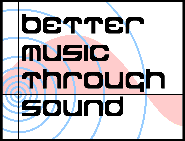
better music through sound
improvisation
the basis for bmts is spontaneous creation, or improvisation. the music/sound created reflects the emphasis on freedom of style and substance on a basic level. the music created may resemble any existing genre of music as much as it may resemble none at all. strictly avoiding any style of music or compositional framework is just as constricting as limiting the participants to a specific mode. this is not to say that exercises in improvisation may not include specific goals, restrictions, or other conscious attempts to regulate the process, but there are no rules and everything is permitted.repetition
repetition is crucial to achieving a refinement and deeper understanding of rhythmic and tonal sequences. repetition can be used to hone a specific idea or emotion. repetition with slight variation can be used to emphasize nuance. repetition of some rhythmic or tonal aspects may be used as a basis upon which other sounds may improvise.collaboration
bmts is not a specific person or group of people. it is not limited to any time or place. bmts benefits greatly from collaboration and through constant shifting and changing of participants. although certain people are frequent partitioners, this is more a function of their availability and desire. those who have participated in bmts many times are no more integral than those who have only participated a few times or rookies.manipulation
the material generated by recording bmts sessions may be manipulated in either analog or digital form. the manipulation may vary from simply repackaging source material in more convenient and useable ways to radically reworking the source material into new sounds, structures, layers, or configurations. normal processes such as the use of digital effects, cut and paste, looping, or other manipulation techniques apply here.